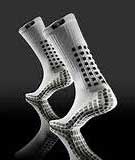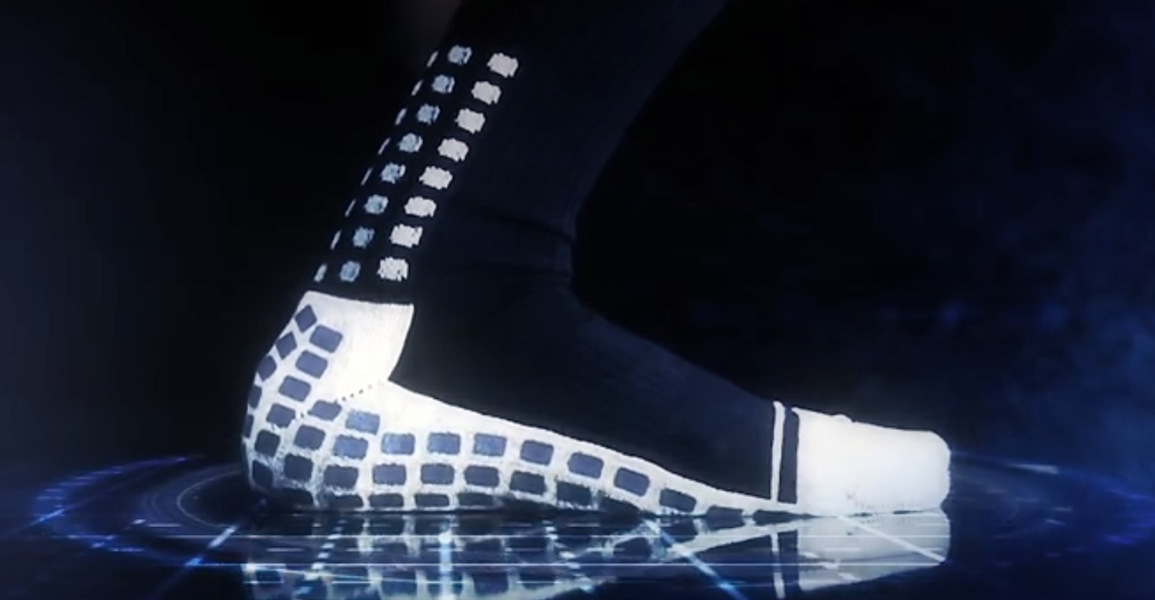
You may even have turned to the person next to you and asked, “What are those dots on their socks?”
I asked a similar question when I saw one of my teammates pulling them on one day. I also looked at her in horror as she took a pair of the trainer’s scissors and cut the feet off her game socks. It seemed crazy at the time.
Now, I can’t play a game without my TruSox.
So what are they? And how did this unknown brand of socks, of all things, spread its way into the shoes of more than a quarter of all English Premier League players in just a few short years? How did a company developed in a garage in Maryland get players to cut the feet off of their brand name socks and at times pay heavy fines for wearing off-brand apparel?
The Back Story
Every athlete who has to change direction repeatedly when playing their sport knows the struggle that comes with sliding around in your shoes, especially on rainy days. Your socks get wet or your shoes have gotten old. Your socks are made from a thin, elastic material rather than thick cotton and you sweat during the course of your session. The net result is that you go to cut and your foot slides a few centimeters in your shoe.
This was the struggle that Jim Cherneski set out to solve when he first began developing TruSox. He was playing and coaching in Maryland for Crystal Palace USA, a minor league soccer team, where several players were already cutting the feet off of their socks so that they could wear regular crew socks underneath.
Cherneski began researching materials and tinkering in his garage. The socks went through several phases, including one that looked like a rubber glove for your foot and another that worked when dry but not when wet. He tried the prototypes out on his teammates and players and eventually came up with a model that seemed to solve the problem.
Despite Crystal Palace USA going under when its English counterpart declared bankruptcy, as well as reaching his own financial limits, Cherneski never stopped believing in his idea. He scraped together the money to patent the product and needed help from several small investors to get the company off the ground.
Using his connections in Europe, Cherneski was able to get the socks into the hands of Victor Moses, who became the first player in the Premier League to wear TruSox. From there, the product has spread through word of mouth and the guerrilla marketing that I experienced when I asked my teammates why they were cutting the feet off their socks. The dots on the back of the ankle of the sock, which mirror the pads on the foot of the socks that give them the patented traction technology, unknowingly became the brands greatest marketing tool. Players saw other players wearing them, asked about them, and tried them out — the socks were passed from player to player, team to team.
To this day, the only player who gets paid to wear TruSox is Luis Suarez, and that is primarily so the company can use his image on marketing materials. All the other athletes who wear TruSox do so because they feel as though the product impacts their game in a positive way.
In fact, many athletes pay far more than the cost of the socks to wear TruSox during competition. Many teams and leagues hand out harsh penalties and fines for wearing off-brand socks. But once the players are hooked, they can’t go back to sliding around in their shoes. This is what TruSox has decided to bank on. Instead of pouring money into advertising and traditional marketing, TruSox has folded that money into research and development, opting to pick up the phone and call people to get them interested and then let the product speak for itself.
The largest hurdle TruSox has encountered is in marketing and the newness of their brand. Once they’ve gotten a player or a team to try the socks, however, the feedback has been just shy of miraculous. From the EPL to the World Cup to the Major League Soccer (MLS) and the National Women’s Soccer League (NWSL), TruSox sightings are popping up everywhere, spreading slowly throughout and among teams, passing between players, and creeping into other sports. TruSox has seen significant market penetration in cricket and rugby in addition to growth in the National Football League, Major League Baseball, and the National Hockey League. Even track athletes and runners have attested to seeing a benefit to wearing the product. Any athlete who benefits from a quicker push-off, turn, or pivot is a potential TruSox customer.
The Product
But what are TruSox? What makes them so special? Can they really stop you from slipping in your shoes? And does this really translate into quicker change of direction and better overall performance?
TruSox come in two different materials, cushioned and thin. The crucial technology, however, is in the small rectangular square on the bottom and heel of the sock. The pads are on both the inside and outside of the sock so that they stick to your foot and the inside of your shoe. Within a few minutes of playing, the socks begin to form to your foot. I can attest to this from experience. Most days when I remove the sock, it stays in the shape of my foot.
While I would describe the feeling of the sock molding to your foot as almost a rubbery feeling, TruSox’s North American representative Andrew Marshall assured me that they are not made using rubber or glue. The pads are in fact covered in tiny hairs, which help with traction in all types of weather. Some players even wet down the sock before heading out to play to speed up the “molding” process.
The sizing of the sock and the fit is important as TruSox is working to make people look at socks as not just apparel but as equipment. Because the sock works with both your skin and the shoe, TruSox cannot be worn with another pair of socks, although two pairs of TruSox may be worn together.
We can discuss the technology at length, and detail the perceived difference players feel in their ability to perform, but what about proof?
As TruSox were spreading rapidly among professional footballers, many people, including those in the Premier League began to wonder the same thing. In one independent study,1 TruSox improved athletes’ agility (as measured by the Illinois Agility Test) by 12.5% compared to a regular soccer sock worn during matches. This has significant implications for soccer players as well as any athlete who runs or cuts while playing.

The Feedback
I wear TruSox. I was skeptical at first about how much they could possibly impact my game. At $40 a pair, I wasn’t sure whether they could possibly be worth it when I already had perfectly good socks that cost me nothing. I’ll admit that while I did feel a difference when I first tried them on, I was not completely sold until my first game last season when I wore the team socks that were given to me. Going from TruSox back to regular socks, I felt like I was playing on ice. The difference was unbelievable. Now I don’t play a game without them.
Editor’s note — The author has not received free TruSox.
The number of players wearing the TruSox is, like I said, remarkable, especially when taking into account the fines they can face if anyone notices. Some leagues have actively fined players. Some sponsors have asked players to stop wearing them, while others turn a blind eye.
Many players in the NWSL wear TruSox, which is where I was first introduced to them. Tori Huster, who currently plays for the Washington Spirit, was willing to talk to me a little bit about her experience with TruSox. She was first introduced to them during the 2014 season by teammate Christine Nairn, who had heard about them through friends of her family.
“At first I didn’t have very many pairs so I only wore them during games,” Huster said. “But now I have them in a bunch of different colors and I wear them whenever I do anything, even working out in the gym. They are just a part of my routine.”
“I feel like they give my foot extra support, especially on hotter days or if it’s rainy. They help me be more efficient in any movement I’m making.”
In a recent photo of the U.S. Women’s National Team (USWNT), two players can be seen wearing TruSox.
While the majority of the national team players who wear the socks have individual apparel contracts and therefore can’t talk openly about TruSox, I was able to ask one USWNT player what she thought of the socks.
“They’re so snug. There is no shifting around,” she said. “They give you maximum security of your foot in your shoes. I can’t remember the last time I played without them.”
She even went so far as to attribute the health of her ankles to using TruSox: “I used to have ankle problems and whether it’s coincidence or not, I don’t have them anymore.”
Part of the TruSox mission is to get players to think of their socks as equipment that can improve performance.
It seems to be working. As Huster so succinctly puts it: “We focus so much on our shoes, why wouldn’t we focus on our socks?”
—–
1. Peacham, Alan, “Effects of The Trusox on Agility and Athletic Performance,” 2014.

